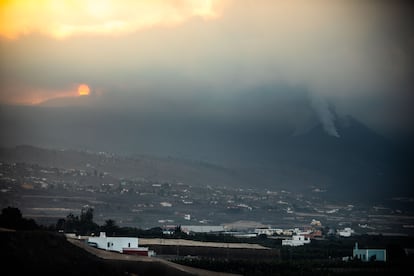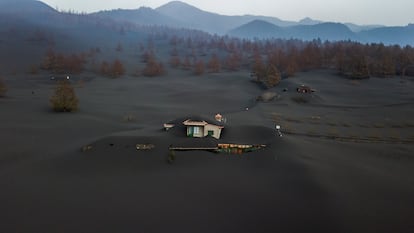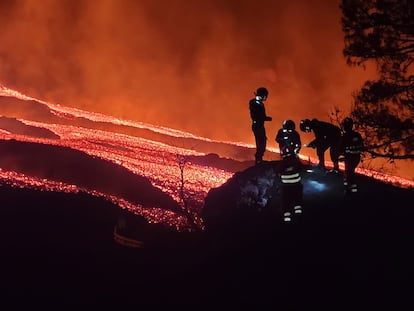La Palma eruption: Life among earthquakes, ashfall and noxious gases
Residents in some areas have been told to stay at home, avoid outdoor sports and wear an FFP2 mask at all times as the volcano spews out more and more lava and pyroclastic material

The lava flowing from the new volcano on La Palma in Spain’s Canary Islands is the most dangerous – and striking – impact of the ongoing eruption. But there have been many other effects on daily life on the island: locals have to deal with feeling the ground shake beneath their feet, being confined due to the risk of possible toxic gases and dust, as well as sweeping up the ash that relentlessly rains down. Day after day. And 46 days have so far passed since the eruption began, on September 19.
Atenea Aguilar (24), Chandra Plasencia (27) and Amanda Marrero are speaking in a square in the town center of Villa de Mazo, a municipality in the southeastern part of the island. Since the eruption, this town and nearby Fuencaliente have become the epicenter of an earthquake swarm that is shaking up residents at all hours of the day.
On Thursday morning, at 7.27am, a 5-magnitude earthquake hit the island as residents were waking up or preparing to go to work. The tremor measured between IV and V on the Modified Mercalli intensity scale (MM), a scale that goes up to XII, with intensities over IV indicating that the quake is felt by the population. This was shortly after a 4.8-magnitude quake was also recorded. On Monday alone, both towns registered more than 90 tremors, 11 of which were felt. And experts say the situation is likely to worsen. The Canaries Volcano Prevention Plan (Pevolca), which is overseeing the crisis, warned on Wednesday that the island will record its strongest earthquakes to date over the next few days.
“We have felt three [tremors] this morning,” explain the youngsters in Villa de Mazo, who are having a break from their gardening studies. “I felt it in the kitchen, all the glasses were shaking,” says Aguilar. “Even my two-year-old son noticed it,” adds Marrero, who lives in the Lodero locality. “I have been living in a caravan for the last three months and you feel all of them in there,” says Plasencia, who dares to ask a question that is on all the minds of the islanders: “Do the earthquakes mean that a volcano can emerge here?”
The response is fast and reassuring. “No,” according to Luca D’Auria, the head of Volcano Monitoring at the Canaries Volcanology Institute (Involcan). The explanation for why is a bit longer. Firstly, the seismic processes linked to the volcano are normal. “All eruptions are preceded, accompanied by and followed by earthquakes,” explains D’Auria. Indeed, it’s likely that there will continue to be earthquakes months or even years after lava stops flowing.
Seismic activity in La Palma – which is part of the volcanic Canaries archipelago off the coast of northwestern Africa – began to increase at the beginning of October and has spiked in the last week. It will take some time, however, before the data collected is carefully analyzed. “But it already gives us the idea that these quakes are related to the readjustment of the Earth’s interior due to the high emission of magma,” says D’Auria. According to the scientist, the volcano – which is located in Cumbre Vieja nature park – has already spewed out more lava, gases and pyroclastic material than other past eruptions, and all within a relatively short period of time. “This volume that is coming out of the Earth has to be compensated by surrounding rocks,” explains D’Auria. And it is this movement that is causing the earthquakes.
More importantly, the seismic activity does not mean that new vents will open up away from the volcanic cone. “The quakes that are taking place are being localized at two different depths: between 10 and 12 kilometers and at more than 30 kilometers,” says D’Auria. He explains that before the eruption, the quakes were “migrating to the surface,” but that has not happened for more than a month. “For it to indicate that new vents could open there would have to be surface earthquakes. And there are none,” he says.
The tremors are now a regular feature of daily life – one that locals on La Palma are having a hard time getting used to. “The earthquakes are a bit scary,” says Elida de Paz, 70, who is visiting Villa de Mazo. But for her, “ash is what is really unbearable: you’re never done cleaning, it gets everywhere,” she says.
Volcanic dust has become a frustrating, and at times dangerous, consequence of the eruption. And every day, more piles up. The amount of ash being expelled by the volcano has multiplied in the past few days. So much so that three municipalities in Aridane Valley – Los Llanos de Aridane (20,171 inhabitants), El Paso (7,623) and Tazacorte (4,600) – have been dealing with heavy ashfalls that have not only blacked out the sun and turned streets into apocalyptic scenes straight out of Lord of the Rings, but have also deteriorated air quality in the area. As a result of the “extremely unfavorable” air quality, as described by Pevolca spokesperson Carmen López, in-person learning at schools has been suspended in the three municipalities, as well as Puntagorda and Tijarafe. Pevolca has also recommended that residents remain at home, refrain from outdoor sport and always wear an FFP2 face mask.
“Firstly, it’s incorrect to talk about ash,” says Pedro Cabrera, a pulmonologist and the president of the Medical College of Las Palmas. “It should be called volcanic sand, given that seen through a microscope it does not look like what is left after the incineration of a human body or a cigarette.” The dust from the volcano, when seen up close, has many edges and is very sharp, which makes it harmful.

According to Cristina Martínez, the coordinator of the Environment department of the Spanish Pulmonology and Thoracic Surgery Society (Separ), inhaling particles that are smaller than 10 microns – which is the case of the material found across the eastern side of La Palma – can lead to serious illness. “[The particles] could reach the alveoli [tiny air sacs in the lung] and this could trigger inflammatory mechanisms that move to the blood and could cause acute sickness or chronic illnesses such as asthma,” she says. Healthy people may even be at risk of experiencing heart problems. And when it comes to the respiratory diseases, the consequences could be lethal.
Making matters worse, the volcano is also emitting carbon dioxide. These gases “are irritants for the respiratory tracts, they can cause rhinitis, conjunctivitis and even affect the trachea and bronchi,” warns Martínez, who explains that this, in turn, can lead to bronchitis, coughing and a feeling of tightness in the throat. “It’s been demonstrated that, in volcanic areas, such as Japan, hospitalizations for this type of illnesses are up to five times greater,” she explains.
But of course, as is always the case, there are also those who claim to be unaffected by the eruption. Antonio Fuentes, who is turning 80 next month, leans against the door of a pharmacy in Fuencaliente. “The ash irritates my eyes a little,” he says, with his face mask half down. “But, to tell you the truth, so far I haven’t felt a single earthquake. Not even a bomb would wake me up.”
Tu suscripción se está usando en otro dispositivo
¿Quieres añadir otro usuario a tu suscripción?
Si continúas leyendo en este dispositivo, no se podrá leer en el otro.
FlechaTu suscripción se está usando en otro dispositivo y solo puedes acceder a EL PAÍS desde un dispositivo a la vez.
Si quieres compartir tu cuenta, cambia tu suscripción a la modalidad Premium, así podrás añadir otro usuario. Cada uno accederá con su propia cuenta de email, lo que os permitirá personalizar vuestra experiencia en EL PAÍS.
¿Tienes una suscripción de empresa? Accede aquí para contratar más cuentas.
En el caso de no saber quién está usando tu cuenta, te recomendamos cambiar tu contraseña aquí.
Si decides continuar compartiendo tu cuenta, este mensaje se mostrará en tu dispositivo y en el de la otra persona que está usando tu cuenta de forma indefinida, afectando a tu experiencia de lectura. Puedes consultar aquí los términos y condiciones de la suscripción digital.
More information
Últimas noticias
Maduro pleads not guilty before the federal court in New York: ‘I am still the president of Venezuela’
A new test can detect Alzheimer’s from a finger prick
UN team enters Sudanese city of El Fasher after paramilitary massacre: ‘It’s like a ghost town’
A recipe for resistance: Indigenous peoples politicize their struggles from the kitchen
Most viewed
- Gilles Lipovetsky: ‘If you want to live better and fall in love, take Prozac, don’t look to philosophy’
- Alain Aspect, Nobel laureate in physics: ‘Einstein was so smart that he would have had to recognize quantum entanglement’
- Alvin Hellerstein, a 92-year-old judge appointed by Bill Clinton, to preside over Maduro’s trial in New York
- Why oil has been at the center of Venezuela-US conflicts for decades
- Maduro’s downfall puts China’s relationship with Venezuela to the test










































